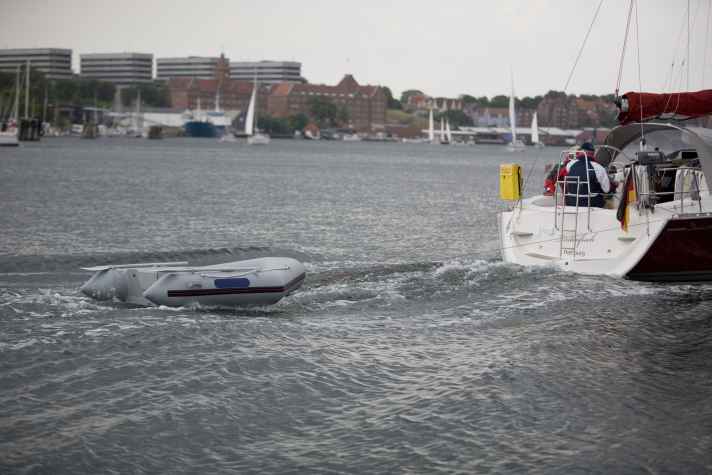
The check-in is done, the berths are occupied, a light breeze blows through the cockpit - the charter holiday can begin. But one person on board cannot quite share the euphoria of his fellow sailors: the skipper. The responsibility for the ship, the technology on board and the crew lies heavily on his shoulders. In the worst case scenario, the skipper is even under constant stress. That doesn't have to be the case.
These 11 simple tips will help make your next sailing holiday a success.
1. no hectic at check-in

Don't let the charter company rush you and don't put yourself under pressure either. A proper takeover is not stuffy, but the best protection to avoid damage and a possible subsequent deposit dispute.
2. all defects in the log
If existing damage is brushed off with a "We know, it was the pre-crew" by the charter staff, caution is advised. Nevertheless, insist on the note in the log and take a signed copy with you. In the event of major damage, take photos with your mobile phone. On your return, it is possible that no base employee will remember this and the discussion about the deposit will start.
More tips on the next page
3. instruct the crew
Bear in mind that the wealth of experience and knowledge in the crew varies. Even if you yourself have been familiar with life at sea for years, the same does not apply to your fellow sailors. Therefore, make sure that all crew members at least know the "basics". For example, how to use the toilet, how to handle holding tanks and seacocks. Or which fuses and main switches are important, when to switch off the refrigerator, where the gas shut-off valves are located. How the radio (DSC!) works, where waistcoats and lifebelts are located, which fuel inlets are where.

4. distribute tasks
Even if you as the skipper are the boss on board: Don't try to solve all the tasks yourself. It is advisable to clearly distribute the tasks on board before the first nautical mile. One person is responsible for the tank levels, another makes sure the batteries are sufficiently charged. For their part, the crew also benefit from such a division of tasks, feel that they are taken seriously and develop a sense of responsibility for the ship and for working together.
5. obtain weather information
Even if the fine weather quickly becomes a habit, especially in the Mediterranean: Check the weather reports every day and plan with realistic sailing times that won't overtax your crew. Always have a plan B in hand if the weather does change.

6. operate sails and winches correctly
Expect your crew to be unfamiliar with the equipment on board and to quickly underestimate the forces, especially with electric winches. Therefore, always check whether the carriage of the headboard or furling main still moves when setting. As a rule, rolling out and in should work without much effort anyway, it can usually be done with your own crank power. The electric winch is only good for the last few heavy centimetres.
Few things are as annoying and expensive as a torn sail right at the start of the trip.
7. discuss manoeuvres and objectives for the day
The most beautiful harbour cinema: the charter yacht arrives at the marina, the crew stands together at the bow or in the cockpit, the skipper looks for a place, drives the jetty - and then the big screaming begins. Nobody is in the right place, no line is clear, no fender is ready.
The skipper has to take responsibility for such a fiasco. It is up to him to explain to the crew at an early stage what needs to be done during the upcoming manoeuvre and who will take on which tasks. Not in the form of "someone has to deploy the fenders", but rather "Klaus, you deploy the fenders!" Only the direct address leaves no doubt as to who is meant. If there is a lot of wind, entrust the most experienced people with the windward lines and make it clear to them that they have the most important job.

8. do not tow the dinghy!
The charter dinghies in the Mediterranean are constantly in high gear, sometimes with whole flocks of children being pulled along behind them, jeering. Merciless UV radiation does the rest. As a result, the vulcanised mounts for the towing lines often tear out and are difficult or impossible to repair. The deposit is gone and with it the possibility of coming ashore dry-shod in a secluded bay. Therefore: play it safe and transport the dinghy on deck.
9. protect the stern section from the harbour mole
Damage to the stern of the yacht due to insufficient tension in the mooring line or anchor chain is just as annoying. That doesn't have to be the case. Simply pull the boat forward another two or three metres using the mooring line after the stern lines have been handed over. Then tie it up and use the engine to bring the mooring line backwards to tension. Not at full throttle, but in such a way that it is well under tension. If the distance to the pier is then right for the plank, quickly attach the lines. And: If available, always deploy the large stern fender!

10 Do not rely solely on electronic navigation!
Groundings in particular have recently been a common occurrence with sat nav apps and plotters. The crew zooms further and further into the chart detail in the plotter when passing flax, losing sight of the scale. As a result, they zoom past flax at intervals of a few dozen metres. It is therefore always better to zoom out and also look at the paper map.
11. show backbone
Skippers don't have to be superhumans. Especially not on your first trip. Do you have the feeling that something has gone wrong? Talk about it, but point out constructively how it could look in future. Then the trip will go even better next time. Even if a lot of work goes into planning and organising the holiday: Don't take criticism personally, but try to learn from it.
Tips by Andreas Fritsch, revised by Felix Keßler.

